CHAPTER 2
L I F E A T H O M E A N D I N T H E F I E L D S
B Y J A N I C E R E I L L Y
Oneida County’s outstanding resources of rich soil, pure water and large virgin forests attracted
❖
early settlers to choose this area as their new homeland. This was the western frontier; the courageous Hop pickers returning after a day
settlers came from New England when they learned greater opportunities for development were in the yard at the Bill Chapman
available near these resources. Self-reliant Puritans tilled our soil, set up grist mills, saw mills, hop farm.
tanneries, and blacksmith shops.
Rural life was isolated and difficult. Blizzards isolated homes for days at a time especially in the Paris Hill-Waterville area where Tassel Hill, the highest point of the county, reigned. Gigantic double-winged snow plows were often stuck. Snow banks were sometimes higher than telephone poles.
The old plank roads spiked from Indian trails and stagecoach routes eventually became passable through the efforts of William Pierrepont White, descended from the first settler, Hugh White, who founded Whitestown in 1784. White was known as the “father of good roads in Oneida County.”
Because of his efforts a farmer could ship produce to local markets knowing the apples in the wagon wouldn’t be bruised, nor the eggs broken, nor a bushel of beans shaken below standards from the jostling ride down a rutty road. Road improvement aided rural mail delivery.
The 1800 farmer sought news from every passer-by. Religion, politics, prices, the state of the country, new lands to settle, gossip and scandal were all in his interests. He learned from the school master whom he took in to board, from the long sermons of the minister, from the political stump speakers, the peddler, the post rider, and from discussions with neighbors at the tavern or country store.
The need to stay in touch with rural neighborhood news, economics and weather during the 20th century was met when a gentleman from Remsen, Ed Slusarczyk, founded the Ag Radio Network in C h a p t e r 2 ✦ 2 3

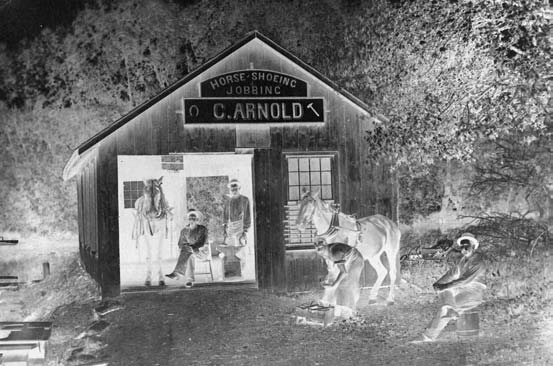
XXON Chapter 2_Layout 1 1/23/2015 12:29 PM Page 24
in the legislature. Slusarczyk helped farmers
solve their problems.
The 1800 farmer may have lacked formal
education and had little book learning but his
children were sent to district schools nearest
their homes. During wartime, bumper crops
and a lack of manpower warranted high school
pupils from farming communities to be excused
early so they could help harvest corn and
‘make hay while the sun shined.’ “Our boys in
the service will appreciate our sacrifices,” said
the Sauquoit Valley school principal.
After centralization, rural students formed
groups called the Future Farmers of America.
An agriculture teacher was part of the school’s
staff; students met with their peers to do
projects. To follow education in the agricultural
fields, young people from Oneida County chose
❖
1976, after serving at a Utica radio station as
to attend college—at nearby Morrisville
Above: The Campbell-Miller Farm,
farm director. He was a commercial farm
Agricultural and Technical College, Cobleskill,
1899. Barns in our area resembled
broadcaster for more than 68 years, respected
or Cornell University where they studied new
the old English and Dutch styles
not only locally but in countries such as Poland,
“agri-business” techniques or veterinary science.
of architecture.
Uganda and Kenya. In 1990 Slusarczyk was
The older generation bragged about their
sent to Poland to teach farmers how to move
children’s thorough college educations.
Below: The local blacksmith repaired
from the collective farm establishment to the
Founded in 1865, Cornell University
plows, wagon wheels, made harnesses
free market. Most every U.S. farmer played a
instituted a cooperative outreach program in
and door hinges, gates and fireplace
radio out in the barn to keep the cows
every county in New York State. By the 1920’s
racks and blades for axes AND he
contented while being milked; now he could
agents from Cornell Cooperative Extension
shoed horses.
hear news of milk prices, livestock reports, and
[now with its Oneida County headquarters in
information about upcoming political farm bills
Oriskany] were employed to teach agriculture
2 4 ✦ O N E I D A C O U N T Y : A n I l l u s t r a t e d H i s t o r y
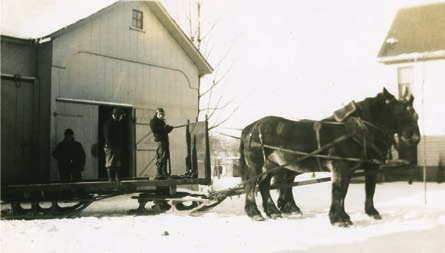
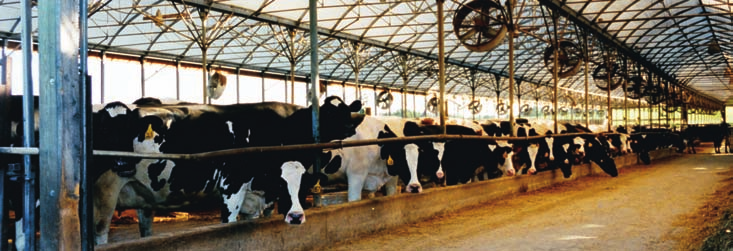
XXON Chapter 2_Layout 1 1/23/2015 12:29 PM Page 25
and home economics. Agents came in direct
contact with the total farm family and
demonstrated progressive ideas for crop
improvement, the rotation of crops, strip
cropping, safe home canning processes, farm
management and a youth program called 4-H.
County Fairs were anticipated by the farm
community for months. The Oneida County Fair
has been held in Boonville since September 1888.
The farmer’s wife showed off her mincemeat pie, a
quilt or a jar of canned pickles. Her husband’s
exhibit of corn or hay would be judged along with
the children’s 4-H prized calf. At the Paris Hill
Fair, held every fall from 1907 to 1938, contests
in nail driving, milking cows and hitching horses
were held. Prizes were awarded for the best sewn
they added a new, state-of-the-art milking
❖
woman’s coat, for the largest squash grown and
carousel which cut their milking time in half.
Above: To get to market farmers had
for the best laying chicken. Best of all, rides in a
Eighty-nine percent of Oneida County farms
to sled their milk over the fields to
real automobile were offered around the park
are family farms. Brabant, an exceptional Dairy
the creamery.
twice for five cents by a careful chauffeur.
of Distinction for thirty consecutive years, takes
At one time Oneida County ranked
its name from the province in Holland where
Below: The Collins dairy farm has
number one in the dairy industry and made
the VanLieshout family originated. Henry and
been in operation since the 1950s.
considerable impact on the county’s economic
Johanna VanLieshout immigrated from the
activities. Oneida County fell to third place in
Netherlands in 1954.Today their five college-
1950s in volume of milk produced and today it
educated sons, Joseph, Paul, Stephen, Philip
still ranks among the top ten counties in New
and Patrick, are in partnership and share the
York State.
farm duties of keeping healthy productive cows
Curtin Dairy in Cassville, formed in 1964,
in the double twelve herringbone milk parlor.
milks 3,200 cows three times a day, producing
Seven hundred cows are milked. The farm
66 million pounds of milk a month! One
contains 1,300 acres. Every five days a fresh
hundred years ago milk production per cow was
supply of new sawdust for bedding is purchased
estimated at 1,700 quarts annually; today the
from a local furniture manufacturer.
average has grown to more than 8,200 quarts
James and Mary Collins began farming in
per cow. The Entwistle farm in the Town of
1953 on Knoll Farm in New Hartford and raised
Marshall made a major investment in the
four sons and four daughters. Only their son
productivity of their 1,000 herd dairy when
Edward remained on the farm. Today Ed and
C h a p t e r 2 ✦ 2 5
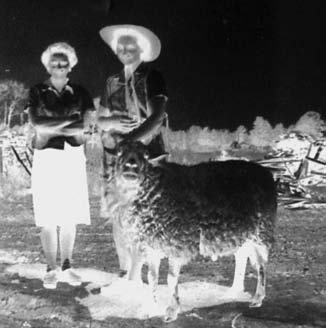
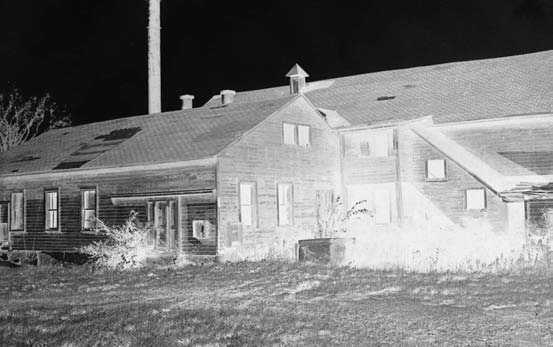
XXON Chapter 2_Layout 1 1/23/2015 12:29 PM Page 26
Candy Collins, and their sons, Rob, Alan, and
David, supply milk through the Dairy Farmers
Association to a large Greek yogurt factory
[Chobani] in neighboring Chenango County.
The Collins’ milk 700 cows and run 2,500 acres
in the Sauquoit Valley and Waterville.
Approximately 216,000 acres in the county is
farm land. In 1919 Oneida County had a total of
6,233 farms. Now there are 1,066 farms according
to the 2012 census. The average size of today’s
farm is 203 acres. Oneida County has fewer farms
since the early 1900s but the farms are larger.
Expensive machinery, heavier taxes that increased
land value and an increase in government
regulations were reasons for opting out of farming.
Farmland then turned into housing developments,
golf courses and shopping centers.
The Pritchards in Lee Center gave up milking
cows in favor of raising fifty Black Angus cattle.
❖
They keep angora and cashmere goats, Shetland
In 1928 John Piersma started the first
Above: A pair of young women on a
Sheep and honey bees on their 300 acres that’s
Holland Farms door-to-door milk delivery. In
farm in the early 1940s.
been in the family since 1853. They find more
1933 his wife Evlyn had her own truck and
leisure hours and flexibility this way.
delivery route which she gave up seven years
Below: Creameries like this one in
In 1914 seven milk trains left Utica daily for
later to have a family. John’s brother Sid did the
1920 were nestled near railroad
the New York City-New Jersey milk shed to feed
bottle production; brother Pierre drove a milk
tracks so milk could easily be shipped
the enormous growth of the city. In the 1920’s
route; Herman ran the dairy farm and Jacob
to New York City. The Rankin
there were more than forty dairies in Utica,
bought a second dairy farm. In 1955 Holland
headquarters was in Brooklyn.
delivering glass bottles of milk daily to the
Farms Dairy Bar & Bakery opened; it exists
customer’s doorstep. Drawn from the farm in one
today in Yorkville managed by two daughters of
hundred pound milk cans to local dairies, the
the founders. Herman Piersma, after 69 years
milk was pasteurized, bottled and distributed.
supplying milk to the community, closed the
2 6 ✦ O N E I D A C O U N T Y : A n I l l u s t r a t e d H i s t o r y
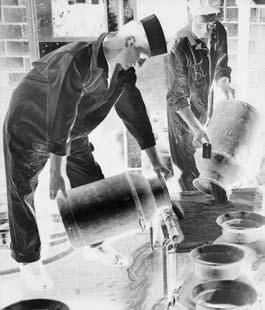
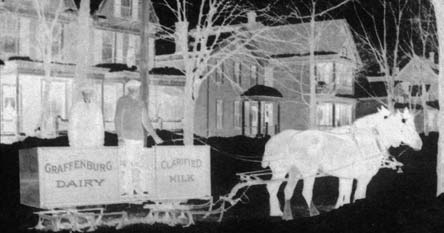
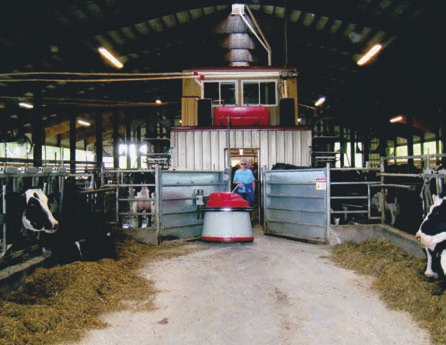
XXON Chapter 2_Layout 1 1/23/2015 12:29 PM Page 27
Piersma dairy business in 1996. Home delivery
of milk and dairy products are now a thing of
the past.
Graffenburg Dairy began in 1915 and grew
to be one of the largest in Utica, serving 5,000
families and handling 12,000 quarts of milk
daily. Twenty wagons and trucks made route
deliveries. Owned by brothers Chester, Elmer
❖
and Harold Owens, it was sold in 1947 to
Top: Pouring the milk from
Dairyman’s League.
the farmer’s milk cans at
The first robotic milking system in Oneida
Dairylea creamery.
County was placed by Lely at the Tayl-Wind
Farm in Cassville in 2012. Steve Taylor and wife
Middle: The Graffenburg Dairy
Sheryl are progressive farmers whose robotic
delivery sleigh.
system milks over two hundred cows three
times a day. The milk is never touched by
Bottom: A modern, robotic
human hands. An identification system of
milking operation.
implanted tags in the ear, recognizes each cow
as she steps into a station in the middle of the
barn and retrieves her history from stored data.
Her weight and position in the stall is measured
as she steps onto a rubber platform. She is
washed and four cups are automatically placed
on her teats by the robot. A computerized ration
of grain keeps her contented while milk is
collected; this process is repeated three times a
day. Whenever the cow “feels” ready, she gets in
line to be processed. Light sensors determine
the milk’s quality and will dump any
contaminated milk and send the good fluid to
the holding tank. A computer again records the
butterfat content, the bacteria count and
statistics of each individual cow. The farm
owner is free to go on a vacation–the computer
notifies him of any changes needing his
attention. Prior to robots a farmer’s day was
24/7. Silage is swept into the feed troughs by a
miniature round robot. Labor costs are kept low
and usually increase profitability.
Shorthorns were a popular breed with early
settlers. The Eighth Dutchess of Geneva pure-
bred cow was part of a herd of cattle descended
from the Bates herd, an English originator of
purebred Shorthorns. The Dutchess was owned
by Samuel Campbell, a wealthy textile mill
owner, who offered her for sale with others of
her breed at his large farm in New York Mills on
September 10, 1873. This sale of pedigreed
Shorthorns was possibly the greatest public sale
of pure bred cattle held in the world and was
attended by cattle buyers from Great Britain,
C h a p t e r 2 ✦ 2 7

XXON Chapter 2_Layout 1 1/23/2015 12:29 PM Page 28
tank and artificially inseminated his herd after
studying each cow’s genetic composition. One
purebred cow of Max’s sold to Carnation Farms
in 1976 and when that business sold her, she
brought $21,000 in a “Top of the Herd Sale.” The
German buyer then used the embryos to sire
sons in Germany. Max was awarded New York
State Retired Master Breeder in 1991. Today’s
dairy herds are improved by using professional
artificial insemination companies.
Summit Crest Farm won the Century Farms
of New York State Award in 1981. About twelve
Oneida County farms have been given the
Century Farm award, an honor presented by the
New York State Agricultural Society since 1937.
To qualify a farm must be continuously owned
by the same family for 100 years or more, be a
successfully managed farm and display a history
of community service.
The patented barns built in 1903 and 1908
on the Utica State Hospital farm were considered
❖
Canada, and throughout the United States. The
the most modern and unique in construction for
One of the barns built on the grounds
Dutchess however was seven years old and had
there were no interior beams or supports. The
of the Utica State Hospital farm.
already produced her full quota of calves. When
273-acre farm had one hundred thirty-five head
she was purchased by an English buyer that day
of cattle that supplied milk for the hospital.
for $40,000, she was in calf and was left at
Forty mental patients did the farmwork—
Campbell’s farm, where a few days before her
feeding and milking cows, plowing the fields,
time, the Dutchess dropped a fully developed
planting wheat, oats and barley, mowing the hay,
dead calf and soon after, died herself.
and harvesting the corn used for feed. They fixed
The most popular breed of cow in Oneida
fences and chopped wood. They planted
County is the Holstein, brought here by the
tomatoes, carrots, and potatoes. The female
Holland Land Company in 1794. David J.
patients canned the fruits and vegetables that
Roberts was nationally known as a Master
were grown. A flock of over 700 chickens
Breeder of Holstein cattle. In 1950 his Holstein
produced 90 dozen eggs per day. Twenty-five
herd was heralded as the best in the nation. At
hundred patients were housed in the Utica State
his farm, Greenaway, in Washington Mills, he
Hospital and soon the farm paid for itself.
developed a famous Gold Medal Sire that sold
The Hospital superintendent, Dr. Amariah
for the highest price ever paid for an Oneida
Brigham, believed it was healthier for mental
County bull—$10,000 in 1961. David Roberts
patients to have physical work and exercise
was a national director of the Holstein-Friesian
rather than sitting in a locked cell. His new
Association for eight years and traveled exten-
ideas were radical but successful. In 1953 the
sively throughout the United States as a repre-
dairy herd and horses were transferred to other
sentative of this association.
state hospitals. In 1954 the lands were trans-
Max Townsend was the designer of the
ferred to Zion Lutheran Church, Utica College,
Holstein purebred dairy herd at his family’s farm,
St. Luke’s Hospital and to the city of Utica.
Summit Crest at Paris Station. His father Albert
Farm land that had previously been rented on
started with 40 milkers and 42 young stock and
French Road was sold to General Electric where
two bulls. Max and his brother Carl increased
a new plant was to be constructed.
the farm acreage to 600 and the herd size to 90
In 1851 Jesse Williams of Rome opened the
milkers and 90 young stock and eliminated the
first cheese factory and Rome became the “cheese
bull. Max froze semen in his own liquid nitrogen
capital of the world.” Jesse invented a machine
2 8 ✦ O N E I D A C O U N T Y : A n I l l u s t r a t e d H i s t o r y
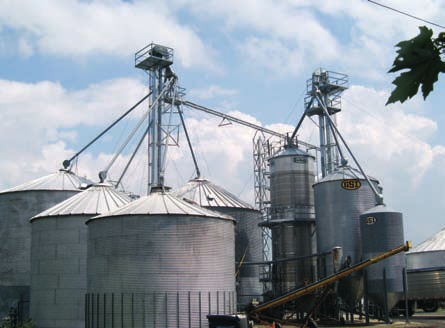
XXON Chapter 2_Layout 1 1/23/2015 12:30 PM Page 29
that converted milk into cheese and made
forecast by watching nature’s signals. His daily
uniform sizes of 150 pounds each, something that
schedule is controlled by the sun; his fortune
had never been done before. Four cheeses were
often lies in the hands of Mother Nature.
made a day, each weighing 150 pounds; later the
Soybeans, rich in protein, are the new kid
size was reduced to 40-60 pounds each. Williams
on the block, exploding in popularity during
bought milk from nearby farmers thus creating a
the last ten years. Six thousand acres are
market for the milk they had not had earlier.
planted to soybeans. Soybeans are roasted at
Nearly every Oneida County town’s history
local feed mills.
reports a cheese factory; at one time 36 cheese
Corn is the largest crop, harvested from
factories were in the Town of Western alone!
35,000 acres. One half of the corn crop is used
The Mennonite Stolzfus Farm in Vernon
to feed livestock—chopped for cattle and blown
Center is an independent family owned dairy
into silos; the second half is used as grain. Corn
making and selling yogurt, and warm and
nationwide is exported to countries for the same
squeaky cheese curd at their own store. The
purpose. Forty percent of corn nationwide is
Farmstead brand is from their own recipe and a
used to produce ethanol fuel. A small amount of
mixture of cheddar and jack cheese. Elsie
corn is grown for human consumption—to
Stolfus created the yogurt recipe in her own
make high fructose corn syrup or ground into
kitchen around the year 2010 when they began
corn meal and flour to make Taco Bell burritos
their business. They use about 1,000 gallons of
and Tostito chips.
milk a day, which is produced on their three
Hops were grown extensively in Oneida
family farms. The cows have access to the out-
County; many farms around the Sangerfield-
doors year round so they can enjoy exercise and
Waterville area had their own hop yard.
sunshine. Whole milk, the old fashioned kind
Waterville soon became known as the “hop
where the cream rises to the top, is sold. All
capital of the world.” Hop prices reached their
products are made with no artificial ingredients.
highest, $1.25 per pound, in the year 1882.
Jacob Stolzfus started making his own Gouda
However, raising hops was a speculative
cheese in Deansboro three years ago. He is
business; prices could fluctuate within a single
❖
currently aging 900 wheels of his cheese on
harvest season. A farmer could go broke or
Dryers on Humphreys Farm
wooden planks and risking the chance his
become excitingly rich!
remove moisture from grains aiding
methods may be banned by the FDA. He is
The hop industry declined around the turn
marketing, storage and processing.
waiting for the agency to decide whether the
of the 20th century. Disease, competition from
One bin accommodates 40,000 bushel
pine boards used are ‘adequately cleanable and
Oregon growers, the depletion of good soil, and
of grain.
properly maintained.’
Mercers in Boonville was once a family dairy
farm. Because of the heavy snowy winters in this
northern Oneida County town, cows produced
milk with a higher butterfat content than might be
found in cows from a milder climate. Around 1950
production of an ice cream began and became so
popular that Mercer quit selling milk and focused
on making ice cream. Today a new invention—
wine ice cream—with a 15% butterfat content, is
globally distributed and sold in forty-five states
nationally. Two women now own the business.
Growing seasons are short in the northeast.
Planting season starts mid-May, if you’re lucky
and there’s no renegade frost, and harvest season
usually ends mid-October. If the corn isn’t knee-
high by the Fourth of July, you are in trouble!
The farmer is often a prisoner of the weather,
weather that he pretty much knows how to
C h a p t e r 2 ✦ 2 9

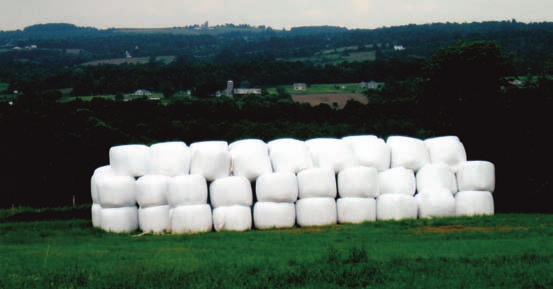
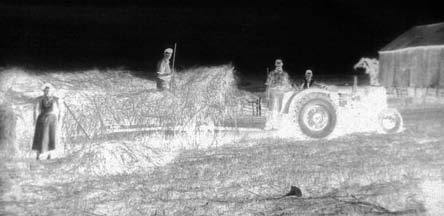
XXON Chapter 2_Layout 1 1/23/2015 12:30 PM Page 30

















